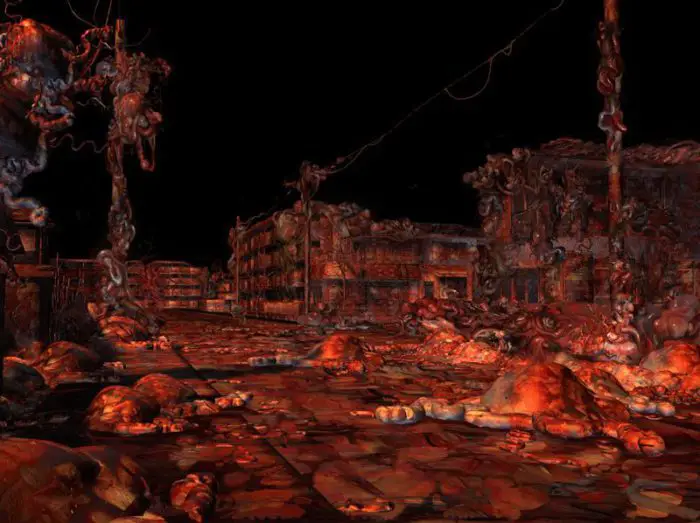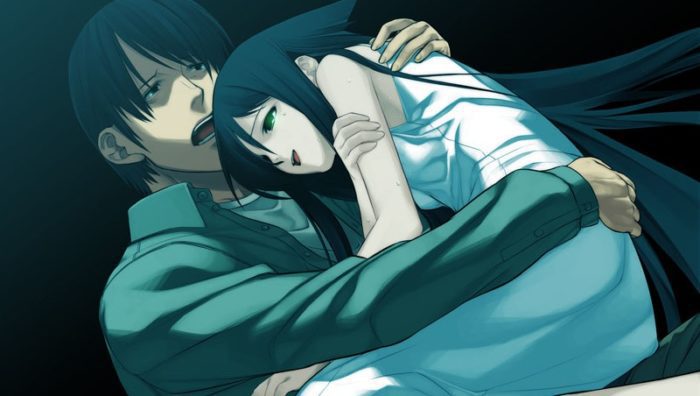Trigger warning: This article contains references to sexual assault and child abuse.
I’m not exactly a stranger when it comes to extreme horror. I’ve written about it a couple of times for this website before, and I read books many would consider to be too much on a relatively regular basis. I find it a fascinating subgenre of horror in that it’s always interesting to see how a creator might push and warp the boundaries of good taste. I’m very much of the mindset that, as long as you approach them from a certain angle, you can write or create a story about almost any kind of subject matter. The trick is that certain subjects need to be handled in a more sensitive way. This personal requirement is why I’d like to discuss Song of Saya. Song of Saya is a visual novel that tackles a lot of taboo topics, but it does so poorly and tastelessly. I was deeply disturbed by the game but not in the way that it intended.
Before we go on, I’m going to give a general trigger warning for this whole article. I’ll be discussing some very dark subject matter including sexual assault, murder, child abuse, and more.
Firstly, though, I’d like to come up with a definition for extreme horror because it’s a pretty wide term that can cover a lot of ground. Stories that fall under this category often push limits in one way or another, whether it’s through a ridiculous amount of gore or in how it approaches topics most people don’t talk about. Even though the violence is relatively low in something like WOOM by Duncan Ralston, it absolutely is an extreme horror novella for just how deep into the twisted mindsets of its characters it gets—that and the extremely graphic self-harm scenes, which are written in an objective, unflinching way. Where other stories might cut away from some of the stuff that happens in WOOM, the book makes sure the audience is aware of every awful thing the characters do to themselves and each other. It gets away with this by being a compelling psycho-sexual horror story about just how damaged a person can be. Extreme horror doesn’t just refer to gore but also to the subject matter.
It’s why I was intrigued by Song of Saya. It’s a visual novel (VN) that, at a quick glance on the internet, has been met with critical acclaim. For those who don’t know, VNs are just what they sound like: primarily story-based games that are accompanied by illustrations and, depending on the game, puzzles and branching narrative threads. I’ve enjoyed titles in this genre in the past, mainly sci-fi focused ones like Zero escape and AI: The Somnium Files. The genre has a certain…reputation, though, and that’s because a pretty large part of it is pretty much just porn. I’m not here to judge, but those kinds of VNs aren’t for me. Regardless, Song of Saya falls into the horror part of the genre, and it’s widely well regarded as a classic.

The narrator in Song of Saya is Fuminori, and he’s fallen on hard times. He is the sole survivor of a car accident that claimed his parents’ lives, and now he’s viewing the world as something alien and disturbing, all fleshy surfaces, gross smells, and disturbing noises. This is literal, by the way; one of the very first illustrations you see in the game is a twisted version of a street where everything is covered in gross-looking skin. He’s become something of an outsider because he views everyone around him as monsters, and I mean that in the most literal way possible. In a very Lovecraftian twist, the viewer is never made privy to exactly what these monsters look like. Instead, we see bits and pieces of them and hear them talk through extremely warped voices. Fuminori is slowly going insane with the world around him like this and would have cracked a while ago if it wasn’t for Saya.
Saya is a disturbingly young-looking girl who appears as, well, normal to Fuminori. She lives with him and has sex with him almost every single night (and of course there are fully illustrated scenes for this that go on for way too long). Fuminori starts to crack despite Saya’s presence, and he becomes hostile towards his former friends and those around him. Eventually, Saya kills one of the “monsters” that Fuminori sees, and together, they eat mysterious blobs from its corpse. This leads them both down a very dark path that ends nowhere good.
So before I get into why this is an extreme horror story that goes too far, I’d like to give my brief impressions on the story itself. I find it interesting but flawed. It’s a fantastic premise for a horror story, but my really big issue with it is that we don’t see Fuminori before the accident. There is no time given to showing him in a normal setting, as a normal person. As such the endings, which are supposed to feel tragic and dark, kind of fell flat for me. I generally like the kind of horror stories where someone is falling off the deep end, but the key ingredient to them is making them feel like a relatable, likable protagonist so that the later plot developments stick the landing. The idea that anyone can be a monster is what makes stories like these horrific, and Song of Saya doesn’t necessarily put in the required work to make its endings feel impactful.
So what’s the problem with Song of Saya? Why would I defend an author like Jack Ketchum, who has some of the most repulsive stories under the sun to his name, and claim that Song of Saya goes too far when he doesn’t? The answer lies in the execution of the story, and I’m going to once again emphasize that trigger warning I made earlier. I’m about to go into some pretty awful stuff. You’ve been warned.
Fuminori and Saya are the protagonist and deuteragonist, respectively, for a good portion of the game’s run time. But once Fuminori bites into the blob Saya gets from another “monster” (it’s pretty obviously human flesh), they both become complete psychopaths. Saya will do anything to help Fuminori, and she’s obsessed with his sperm because, as it turns out, to the surprise of absolutely no one, she’s an alien who can alter peoples’ minds. She did that with Fuminori. She is driven to reproduce, which explains her high sex drive. And that sex drive rubs off on Fuminori in the most vile way possible.
At one point, one of Fuminori’s friends named Yoh goes to his house to check on him, but she’s attacked by Saya in a scene that gives players the first glimpse of her alien form and nature. She alters Yoh’s brain to become completely subservient and unable to fight back. Can you see where I’m going with this? She is turned into a sex slave for the duo, and of course in the scene where her mind is altered, she’s actually just full on r*ped by Saya, complete with tentacles and illustrations depicting full penetration of an alien phallus.
And the scene where she is assaulted and r*ped by Fuminori and Saya? It goes on for about fifteen minutes and also comes with its own sets of illustrations and sound effects to make sure that the viewer knows every single vile thing they do to her. It’s beyond repulsive on many levels, and all of this comes after a scene where Saya alters the mind of one of Fuminori’s neighbors and is r*ped by him. Once again, everything is shown, and it’s made all the more disgusting by Saya’s design, which is deliberately made to be childlike.
I don’t even know where to begin with any of this. From a pure story perspective, it definitely made me realize that the two characters are the villains of this story. The thing is that the game’s endings try and turn them into sympathetic characters in that they were two lost souls who found each other in a twisted world. The problem is that these previous scenes, where you are told everything that they do to their victim, did away with any sympathy I might have had up to that point. Remember earlier when I said we never see Fuminori as a normal person? Seeing him go from average guy to a murderer/rapist due to his perception of the world could have been pretty damn effective.

And here’s the thing: sexual violence is something that can be used in stories effectively, but it has to be portrayed with a delicate hand. In the Jack Ketchum novel Stranglehold, there’s a plot twist where it turns out the protagonist’s sociopathic ex-husband has been anally r*ping their son. It’s a legitimately upsetting revelation, and it comes at about the mid-way point. Up to that point in the novel, the reader is aware that the husband is not a good person, but they weren’t aware of just how depraved he is. The way this revelation is handled, though, is pretty much as tastefully done as you can with subject matter like this. The son refuses to go to the bathroom, screaming that it hurts, and it’s there that the reader and the protagonist realize what was going on.
The key to that plot development is that the viewer is never actually subjected to the abhorrent act itself. They see the aftermath and how it affects the victim, but Ketchum wisely realized that there’s no proper way to write a scene about that happening to a kid without coming across as a vile piece of garbage who fetishizes sexual violence towards kids. Ketchum knew exactly where to draw the line. He knew exactly where it would stop being a disturbing story and start being a really messed up piece of disgusting pornography.
Song of Saya, on the other hand, revels in these acts of sexual violence. Each r*pe scene goes on for several minutes, and the narration is written like an erotic scene. I’ve seen people online argue that this deliberate showing of their depravity is supposed to really make you hate them, that despite how far it goes, it all serves the story. Except, I can think of a million other ways you could have approached these scenes and not have them featured what appears to be a naked child holding down a fully grown woman while a fully grown man r*pes her.
This is even more baffling when you consider the game’s approach to its violence. There’s some extreme brutality in here, but most of it isn’t illustrated or, if it is illustrated, it is done so sparingly. For instance, when Saya alters the mind of Fuminori’s next door neighbor, he murders his wife and kids. We don’t see any of it but get some slight narration and voice acting from it. In other words, the game leaves the viewer to fill in the blanks about what’s happening. After all, suggestion is a powerful thing, and when used properly, it can be more disturbing than showing a violent act. I can’t for the life of me begin to understand why the same approach wasn’t used with the sexual violence.
Or, rather, I can’t come up with any explanation that doesn’t involve the creators of the game being twisted individuals who should be put on watch lists. The fact that these scenes go on for so long and that they’re illustrated in a way that leaves nothing to the imagination gives me the impression it was all written and drawn one-handed. That’s what I mean when I say that Song of Saya disturbed me for all the wrong reasons. A story about a normal person becoming a monster due to circumstances beyond their control is disturbing in a good way. Scenes that depict a person being used as a living sex doll that feature full penetration and sound effects is disturbing in a really disgusting way.
The reason that I’ve focused so much on these parts of the story is because they overshadow any good will the story might have otherwise had. Extreme horror is constantly walking a very fine line between genuinely compelling dark fiction and violent smut, and I think that Song of Saya falls on the latter side of that line. It’s unfortunate that such an interesting premise was undermined by some really regrettable creative decisions. Instead of impressing me with a dark story, it made me feel disgusting in all the wrong ways.
There’s clearly an audience for this sort of thing; as I said near the beginning of this article, it’s a generally well-regarded VN. And the thing is that if you look into the subgenre, you’ll find that this isn’t even the most aberrant example of a horror VN with erotic elements. There’s much worse stuff out there for people who are into that sort of thing, but for me, I think I’m better off not knowing who those people are. As it is, Song of Saya is, for me, an example of extreme, boundary-pushing fiction going way too far.
Looking for more horror gaming impressions? We’ve got you:
“Man of Medan: Day One Review”
“Control Review: Let Aesthetic and Gameplay Drive”
“The Bird Watcher, the Smuggler, and the Assassin—Paratopic”
“Horror and Bunnyhopping: DUSK”
“The Yomawari Games Are Examples of How a Good Aesthetic Can Help a Game Overcome Its Design Flaws”
“First Impressions of Days Gone on PS4”


